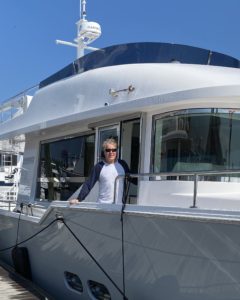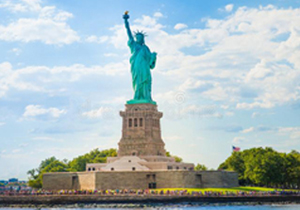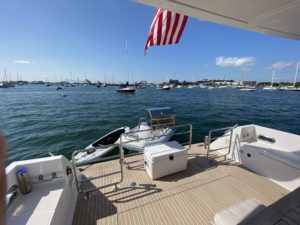Cruising Coastal New England – Outback style
with Andrew Cilla
Why did it take so long? I had spent too many years dreaming of transiting between Ft. Lauderdale and the popular cruising spots of New England, but with the arrival of my new Outback 50, I knew it was finally time to embark on this long anticipated adventure. As I reflect on all the beauty we have seen and the gracious people that we have met on our odyssey, I am very grateful that I never gave up on my quest to undertake the journey.
Over the past 10 years, I’ve been working to develop the ideal vessel to enjoy future boating with family and friends. My 50 years in the marine industry and 40 years of boat ownership served to create very specific criteria. A big part of what drove my design brief with Michael Peters Yacht Design was the ability to enjoy a voyage, such as this one, as effortlessly as possible. Simplicity in docking and the ability to run offshore comfortably and efficiently were high on my list. This made her the perfect vessel to travel the long distance between Fort Lauderdale and New England. As a boat designed for both performance and recreation, she handled quick offshore spirits smoothly and effortlessly and her comfortability allowed us to relax and enjoy the slow, peaceful meanderings through miles of remote coastal villages.
The first step of the journey was selecting my first mate and I managed to find the perfect companion for the journey, my good friend Lori. Lori and I have enjoyed many long weekends onboard my new Outback as well as a few years of weekend boating on my Nordic Tug. Originally from Maine, Lori was anxious to spend the summer in her old backyard. But even as a former resident of New England, Lori’s journey aboard the Outback would allow her to experience coastal New England in a completely unique way.
Our first challenge was one that I would have never predicted while dreaming of this trip in previous years, the emergence of COVID-19. We recognized that we could be required to quarantine when stopping in certain states on our trip North. Fortunately, we encountered sensible courtesies from all the marinas we visited. Departing in mid-June, our goal was to push hard to get to Annapolis quickly so we could escape the beginning of another muggy summer in the sweltering Florida heat. So, for now, we would enjoy the excitement of running offshore at a comfortable 16 to 20 knots, and plan for the joys of transiting the Intercoastal Waterway (aka ICW) for trip South.
Annapolis has always been one of my favorite places to visit. I’m especially fond of its nautical charm and idyllic rivers and creeks. We ended up spending a week berthed at the charming City Docks. We quickly realized that we were likely to walk more than we had ever imagined and log more miles on our 10’ tender than onboard the Outback. While we both have been to Annapolis dozens of times, we had never arrived by boat before and experienced the tranquility of resting in its historic harbor. Our excitement was quickly building because we realized that if each port of call was as breathtaking as our first, we were going to have one very special summer.
On a perfectly delightful morning, we departed Annapolis with the intention of pulling into Cape May, NJ before dinner. We found that the further we traveled North on the Chesapeake Bay, the more captivating our unfamiliar surroundings became. Once we entered the C&D canal, we got our first taste of what the ICW was going to feel like on our return trip. Born and raised on the Jersey shore, I made a point to hug the coast so I could see the various communities, boardwalks, and beaches I visited in my youth and still hold fondly in my memory. That evening we pulled into Norwalk, CT for fuel, a nice dinner, and an early start to our brief final leg to our summer base, in Newport, RI.
Of all the places I have been, Newport remains my favorite. I’ve had a mooring in Newport Harbor for the last four summers, every one of which has been magical in its own distinctive way. Previously, I had my Nordic Tug delivered and my personal transit time was approximately 3 hours on Southwest, assuming I got a direct flight. From the security of my mooring buoy, I’ve witnessed the greatest display of boats anywhere on the East Coast each summer. I’m as fond of watching the lobster and ocean scallop boats leave in the early morning fog as the mega yachts returning with their charter guests to enjoy Newport’s excellent restaurants. I would venture to say that the mooring field in Newport Harbor is the largest and most impressive on the East Coast, while still holding a distinctly New England, historic charm. I’ve become buddies with the neighborly launch drivers and friends with many of the families moored around us. And now, here in Newport for my fourth summer, I feel like it’s really home.
Another appealing and convenient feature of Newport is that it is an excellent base to enjoy quickly zipping around New England, as we did. Martha’s Vineyard, Nantucket, Block Island, Sag Harbor, and Cape Cod are all just a few hour trips on our Outback. In the nearly 3,500 miles we traveled, we never had to throttle back. Running offshore, we could choose the speed that suited our plans. We treated each of our destinations as a new adventure! Once we had the Outback secured, we typically would hop on a scooter, or in the case of Martha’s Vineyard, a blue Mercedes convertible, and toured our destination by land. The remaining time we toured the island with our dingy while often towing our paddleboards to explore the numerous creeks and ponds. Certainly, some of our most memorable vistas were experienced from a paddleboard, seemingly far away from civilization. Our biggest surprise was the little island of Cuttyhunk, last in the chain of the Elizabeth Islands, South of Cape Cod. With a whopping population of four during the winter months, this cute little island offered a dramatic and welcomed contrast to the more heavily traveled New England destination.
After the best summer either of us has ever experienced, a quick drop in the temperature (a brisk 52°, foggy morning in Newport) convinced us it was time to head back South. We were anxious to explore more of the ICW and thus our return voyage began. Our first leg brought us to New York City.
The views from the East River were truly remarkable. We took a slight diversion and zipped up a portion of the Hudson river to see more of the city’s distinctive skyline, somehow even more impressive by water. The next day we were back in Cape May. From there we decided to explore the Eastern Shore of Maryland since we had already spent a week in and around Annapolis, on the state’s Western Shore. On our second night, we pulled into quaint St. Michael’s. What we thought would be a one or two day visit turned into a week. We absolutely enjoyed walking, touring with our dingy, and paddleboarding through this picturesque community and the many nearby tributaries.
Once again we started to feel an unbidden chill in the air and knew that, like the geese, we should be heading further South. However, we would discover that perhaps we were in just a little too much of a rush; Hurricane Teddy had rapidly emerged and begun churning threateningly off Bermuda, creating fierce winds out of the North in the Chesapeake Bay. I quickly realized that 6 to 8-foot seas in a shallow body of water, like the Chesapeake Bay, can create sea conditions similar to running a treacherous inlet. This was a big problem…while inlets are typically a few hundred yards, we had to run 120 miles to Norfolk. The further we got into the open bay the more challenging the seas became. It wasn’t long until we came to the chilling realization that there were no other boats in sight. Fortunately, the Outback is designed much like a pilot boat, purposely built to run inlets. All of the fuel and water are positioned over the center of buoyancy. She is narrow with a long waterline and has just the right amount of weight aloft (superstructure) to provide a safe ride in these seas. Here again, we didn’t need to slow down. In fact, she was more comfortable at 20 knots than slower speeds. While it wasn’t the most comfortable portion of the trip, we did get to where we were headed very quickly. Finally, after escaping the threat of Hurricane Teddy, we were very excited to begin our contrastingly relaxing ICW venture from Norfolk. What a difference our voyage was through the placid waters of ICW to the previous day’s adventure in the Chesapeake Bay! I’ve always lived on the water and spent more time than most knocking around on all sorts of boats, but I never imagined how much I would enjoy what we viewed and experienced on this uniquely arcadian inland waterway.
Our first night on the ICW brought us to Oriental, NC, one of many little charming communities on the waterway. Everyone we met was extremely welcoming and openly hospitable. I was told there was a traffic light in town, but after miles of strolling through this tranquil community, we never found it. Like most that navigate the ICW, we knew that a stop in the tiny town of Coinjock, NC was a must. No stoplights in this community of 335. The next night was spent on Bald Island, a private resort community we toured by golf cart. Then, suddenly, things took another unexpected turn; We lost forward gear on our port engine. Fortunately, the Outback has a keel. Not only does it serve to protect her running gear, but it also dramatically increases her directional stability. We were able to continue on through the windy stretches of the ICW at a comfortable 10 knots. The plan was to get to Charleston and have a Cummins rep take a look. Turns out, it was a solenoid which they couldn’t locate and so we switched out the reverse solenoid. Fortunately, we could now continue the trip with both engines operating in forward gear, but, unfortunately, with no reverse on the port engine. However, with variable speed bow, stern thrusters, a pilothouse door, and full walk-around side decks, docking was never an issue. Still in Charleston, we docked at an outside slip at the mega dock in Charleston city marina. We ended up staying longer than we thought waiting on the Cummins mechanic, but with all the things to see and do in this idyllic historic city, no one complained. Our next run was to Savannah where we spent three delightful days strolling the cobblestone streets of the endearing town veiled in Spanish moss. With all of our dillydallying, we decided to knock off the remaining 400 miles in two 10 hour days. After an overnight in Daytona Beach, we were home in time for supper. With the excitement of returning home upon us, it was a pleasure to be able to dependably count on comfortably running at 20 knots offshore.
After returning home even quicker than planned due to our speed offshore, Lori and I confidently declared that the trip greatly exceeded even our highest expectations. Apart from the memories of this impactful journey, I was left with the gratifying feeling that I had been part of creating the ideal vessel to transit the East Coast, while still noting a number of small changes and modifications that will make future Outbacks even a tad better. And although there is always relief and comfort in returning home, a part of me yearns to be back aboard the Outback on my peaceful mooring buoy still watching the sailboats sway gently in the Newport harbor. I already have my mooring reserved for next summer!



















